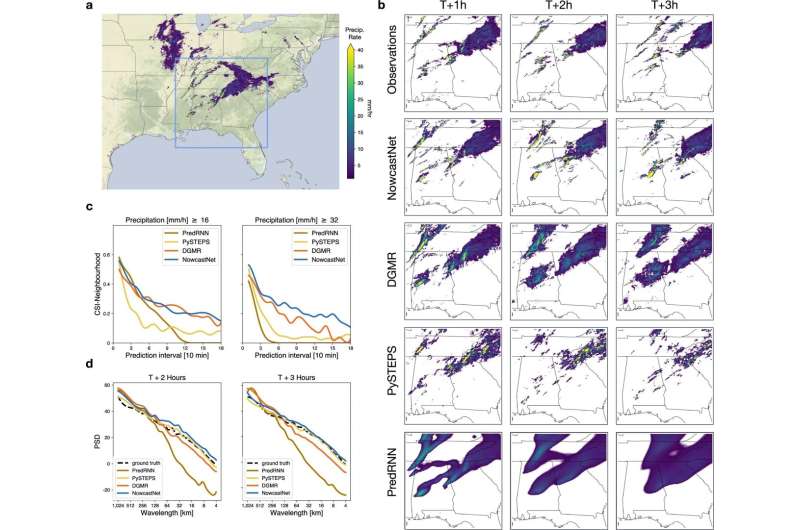July 10, 2023 report
This article has been reviewed according to Science X's editorial process and policies. Editors have highlighted the following attributes while ensuring the content's credibility:
fact-checked
peer-reviewed publication
trusted source
proofread
Two new AI-based weather-forecasting systems challenging the status quo

Two teams of AI engineers have independently designed, built and tested two new AI-based weather-forecasting systems that have been found to be as accurate as existing systems.
The first team, made up of engineers at Huawei Cloud, in China, built a system called Pangu-Weather. It was designed to predict weather a week in advance. The second team, with engineers from Tsinghua University, in China, working with one colleague from the China Meteorological Administration and another from the University of California, Berkeley, has built a system called NowcastNet. It was designed to predict precipitation levels for the upcoming six hours.
Both teams have published papers in the journal Nature describing their systems and how well they have done during testing trials. Imme Ebert-Uphoff and Kyle Hilburn with the Cooperative Institute for Research in the Atmosphere at Colorado State University, have published a News & Views piece in the same journal issue outlining the challengers of building AI weather-predicting systems and the work done by the teams on these two new efforts.
Currently, the most reliable form of weather-forecasting comes courtesy of numerical models that accept current weather data and apply math and physics formulas to make predictions about upcoming weather. Such systems are considered to be quite reliable, at least for major metropolitan areas—but they are CPU intensive, taking hours to calculate results.
But because weather forecasting is so important to farmers and for providing warning of dangerous storms, scientists continue to look for ways to improve prediction results. One promising area of research is AI—where instead of running formulas, systems are given historic weather data and use it to make predictions about the future.
In the first effort, the team behind Pangu-Weather, trained their system on 39 years of weather data and then asked it to make predictions based on current weather patterns. They found that it was as accurate at doing so as existing systems, and did its work in just a fraction of the time.
But it does suffer from one major drawback—it does not make any predictions about precipitation amounts. Instead, it returns estimates of temperature, wind speed, air pressure and other weather-related data. Humans are then left to make prediction estimates based on what the system shows them.
NowcastNet, on the other hand, does just the opposite—it tries to give accurate predictions about the amounts of precipitation a given area will receive in the upcoming six hours. It does so using both historical data and physical rules. It too proved to be as accurate as conventional systems and also returned results much faster than conventional systems.
Both teams note that their systems are currently still at the test-of-principle stage but also suggest that their results thus far hint at the possibility of AI-based weather predicting soon becoming the standard approach.
More information: Yuchen Zhang et al, Skilful nowcasting of extreme precipitation with NowcastNet, Nature (2023). DOI: 10.1038/s41586-023-06184-4
Kaifeng Bi et al, Accurate medium-range global weather forecasting with 3D neural networks, Nature (2023). DOI: 10.1038/s41586-023-06185-3
Imme Ebert-Uphoff et al, The outlook for AI weather prediction, Nature (2023). DOI: 10.1038/d41586-023-02084-9
Journal information: Nature
© 2023 Science X Network




















